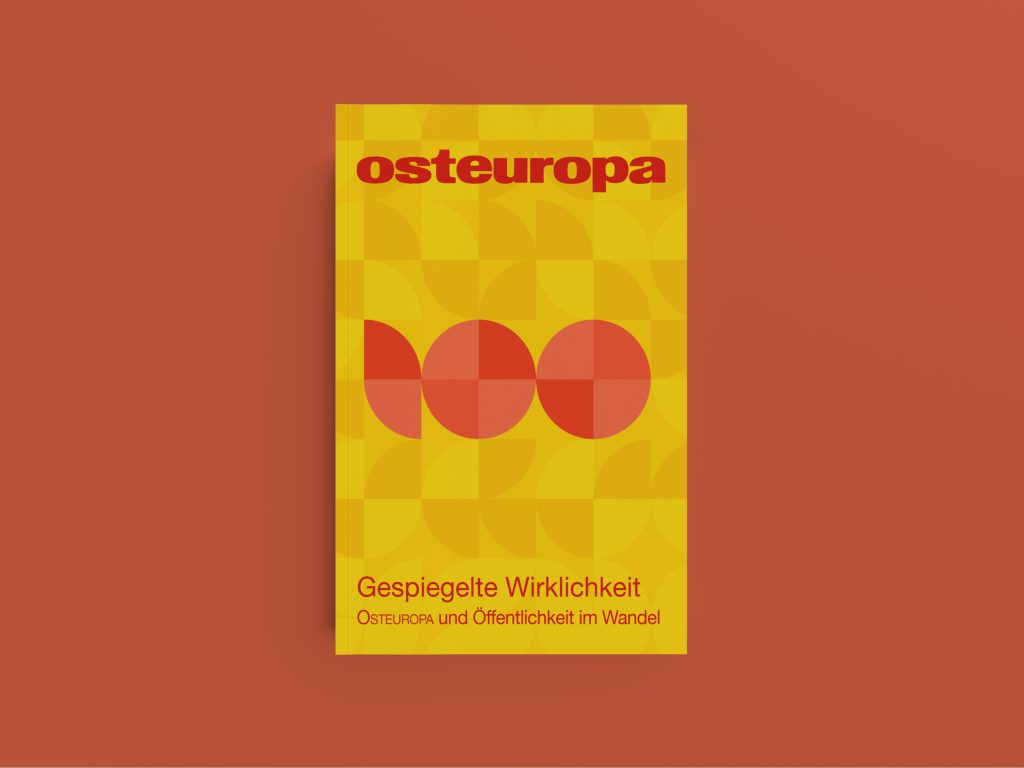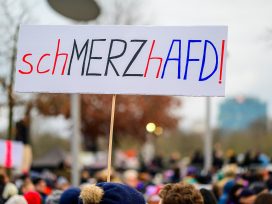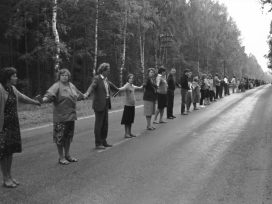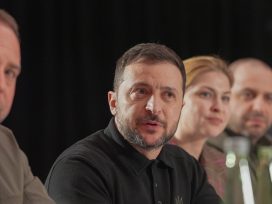‘In the spirit of the times and against the grain’: with the title of his introductory essay to Osteuropa’s centenary issue, the journal’s longtime editor Manfred Sapper alludes to the contradictory history of the publication, which in many ways mirrors the tortuous course of Germany’s historical relationship to Russia, the primary object of Osteuropa’s inquiry over the past century.
Osteuropa began publishing out of Berlin in 1925. ‘Embodying “the spirit of Rapallo”’, the 1922 treaty that established diplomatic relations between Germany and Soviet Russia, it was the brainchild of Otto Hoetzsch, a German historian and politician. Nearly a decade earlier, Hoetzsch had founded the German Society for the Study of Russia, the forerunner of the German Society for Eastern European Studies (Deutsche Gesellschaft für Osteuropakunde), the current publisher of Osteuropa.
Then as now, Osteuropa ‘was never a narrow, specialist journal for politics or economics,’ according to Sapper. Rather, ‘It was intended to forge a link between science and politics, knowledge and curiosity, enlightenment and action … It was, from the very beginning … “interdisciplinary”’.

Not long after Hitler’s seizure of power, Hoetzsch was denounced as a ‘cultural Bolshevik’ and all but forced to resign. He was replaced by Werner Markert, one of whose early contributions – entitled ‘The study of eastern Europe as a scientific and political task’ – concluded that, ‘for scholarship, too, the path to the East means war … Our work is to prepare the way that the Führer has marked out for us.’ As Dietrich Beyrau wrote in the journal in 2005, this position legitimized National Socialist policies of exploitation and annihilation in eastern Europe. But it did not prevent Markart from taking up a chair at the University of Tübingen after 1945, where he had a significant influence on German historiography on eastern Europe.
Osteuropa began publishing again in 1951. The editorial to the first post-war issue incarnated the peculiar blend of ‘silence, repression and self-pity’ that characterized the German attitude to Nazi crimes in the conflict’s immediate aftermath, writes Sapper. Sentiments such as ‘the German people have made more earnest and intensive efforts than any other to gain knowledge of eastern Europe and its peoples’ were typical, as was the lament that ‘the loss of the eastern territories, with their universities and libraries … inflicted heavy losses on German research on the east’. In fact, German war crimes went unmentioned in the journal until 1989; and it was not until 2002 that Osteuropa published an essay directly addressing the Holocaust.
During the Cold War the editors would adopt Hannah Arendt’s thesis in The Origins of Totalitarianism postulating the structural similarities between fascism and communism. This, Sapper notes, ‘had the welcome side effect for many members of the generation involved in National Socialism of helping to relieve their political burden’. So much did Osteuropa mirror the fledgling BRD in its fierce anticommunism that writers and academics deemed soft in their commitments were shut out.
The journal did, however, go against the grain in stressing the ineradicability of national and ethnic affiliations, not only in the Warsaw Pact countries but also within the Soviet Union itself. A key text in this regard was Hélène Carrère d’Encausse’s early-1960s study of the Kremlin’s largely futile attempts to ‘Sovietize’ the population of the South Caucasus.
Though Osteuropa pivoted away from Russia after the fall of communism and toward the newly independent states of eastern Europe, it has been a faithful chronicler of Russia’s two-decade-long reversion to authoritarianism under Vladimir Putin. Through it all the journal has maintained its hybrid character, according to Sapper: ‘It is too journalistic for academics, too academic for journalists, and not operational enough for politicians and diplomats. In short, it straddles many worlds’.
The fatal nexus
Historian and longtime Osteuropa contributor Gerd Koenen describes the swirl of fantasy and projection that distorted the Russia’s and Germany’s views of each other in the interwar period, and that fomented some of the bloodiest battles in the history of warfare, the meaning of which is still being instrumentalized today.
In the disastrous wake of the First World War, it was perhaps natural that the two countries cut out of the post-Versailles world order would view each other as ‘comrades in suffering’ bound ‘each to the other by a shared nature and fate’, as Hoetzsch put it in his introduction to the journal’s inaugural issue. For the defeated Reich, the Ost was a tabula rasa upon which a phantasmagoria of political and social renewal could be projected. Those on the Left regrouping after the failed November Revolution could dream of a future ‘Soviet Germany’, while early Nazi theoreticians could posit affinities with ‘White’ Russia. Only later would Hitler definitively redefine the party’s ambitions in the East in the brutal language of conquest and the acquisition of Lebensraum.
The Soviets, meanwhile, had delusions of their own regarding their neighbours. Lenin ‘saw from the outset that a connection with Germany, with its technical, industrial, and scientific prowess, was the key to establishing state socialism in Russia’. Nor did Germany’s descent into fascism dent his successor’s determination to fulfil this vision, since in Marxist theory bourgeois capitalism and fascism were merely two sides of the same coin. Nazi Germany thus became a blind spot for the ‘notoriously mistrustful’ Stalin, who was caught off-guard by the German invasion in 1941.
Koenen goes on to trace the afterlife of the ‘Great Patriotic War’ in the Russian imagination, concentrating on its most recent deployment by Putin in his Ukraine campaign via the rhetoric of ‘denazification’. He concludes with a puzzled glance at what he regards as the illogical, schizophrenic German response to Russian aggression, characterized on the one hand by a vaguely pro-Russian former East and an insufficiently resolute former West. The repercussions are still sounding.
In and out of the shadows
In one sense, ‘A world in shadow’, the title of Katharina Raabe’s discussion of the post-1989 emergence of eastern European literature and its reception in Germany, belies its narrative of efflorescence – its emergence out of the shadows and onto the broader European stage. And yet, the penumbra persists in places like Ukraine and Belarus, which have remained a ‘grey area’ in the European imaginary, so much so that the exiled Belarusian writer Alhierd Bacharevic recently described himself as ‘an author from nowhere who writes in a language that does not exist’.
‘Since Russia brought war back to Europe’, writes Raabe, an editor at Suhrkamp Verlag, ‘the term “eastern Europe” has once again come to stand for a space of violence and existential defencelessness. As a result, the question of whether there is a specifically eastern European literature – and, if so, what characterizes it – has suddenly returned’. Raabe then offers a provisional definition: ‘eastern European literature emerges wherever the writer is left isolated and exposed to political violence in its most absurd manifestations’.
Given the vastness of her subject matter, rather than offer a broad survey, Raabe proposes ‘exemplary constellations’ of writers who have found a belated readership in Germany and who thereby expanded Germans’ understanding not only of the region and its history, but of themselves as well.
One such constellation is the Hungarian dyad of Imre Kertész and Peter Esterházy, two writers whose ‘literary physiognomies might stand for two poles of the eastern European sensibility’. Kertész’s novel Fatelessness, originally published in Hungary in 1975, tells the semiautobiographical story of a 14-year-old boy who is plucked off the streets of Budapest and sent to Auschwitz, and who describes his ordeal in a detached, clinically off-kilter style. It struck a chord upon its publication two decades later in a Germany anxious over the recrudescent antisemitism that had flared up in the wake of reunification. In his essay ‘Holocaust as culture’, Kertész voiced a notion of collective responsibility that synced with the evolving national consensus around Erinnerungskultur (‘memory culture’): ‘Today we know: survival is not only the personal problem of the survivor; the long, dark shadow of the Holocaust lies over the entire civilization in which it happened and which must continue to live with the burden and consequences of what happened.’
Whereas Kertész, who won the Nobel Prize in 2002, would come to feel misunderstood and unwanted in Hungary in spite of (or perhaps because of) his German renown, Esterházy found early success at home. He took longer to catch on in Germany, owing to the unique challenges presented by his writing, which has been alternately described as a ‘postmodern ornate castle’ and the epitome of a ‘central European poetics’ characterized by ‘the immanent presence of culture in the form of allusions, reminiscences, quotations from the entire European heritage’.
Esterházy’s magnum opus, Celestial Harmonies, a ‘vast anti-epic’ that chronicles a Hungarian noble family, found success in Germany upon its publication in 2000. In contrast to Kertész’s ‘incessant circling around the question of the human condition after Auschwitz’, Esterházy’s Weltanschaaung was stamped by an ‘ontological serenity’. In response to Kertész’s pronouncement that ‘the signs of horror are recognizable everywhere and in everything’, Esterházy would write, ‘I don’t see it that way, partly because I am blind, partly because I see something else’.
Raabe adds a pair of dissident Russian writers to her constellation, one contemporary and one from the middle of the previous century. The first is Vladimir Sorokin, whose career parallels in resonant ways that of Kertész: both were writers-in-residence in Berlin in the early 1990s when they were being ‘discovered’ by a German audience. The second is Varlam Shalamov, who wrote six volumes of minutely observed autobiographical stories set in the Gulag, and would find a posthumous audience in Germany only in 2007, just as Russia was again slipping into repressive rule.
As a final counterpoint, Raabe discusses the Ukrainian authors: Yuri Andrukhovych, whose essay collection My Final Territory maps the palimpsest that is western Ukraine; and Serhii Zhadan, poet, playwright, rock musician, and currently soldier in Ukraine’s National Guard – whose career underlines the precariousness of the visibility vouchsafed those who step out of the shadowlands of history.
Classical politics
Dorothea Redepenning refracts changing German attitudes toward Russia through the prism of classical music. The picture that emerges, she notes, ‘illustrates the extent to which political factors shape perceptions, as well as the extent to which nationalism hinders culture and dialogue’. During the Weimar years, for example, a shared sense of ostracization vis-à-vis the post-Versailles dispensation brought the two countries together in a phase of lively musical interchange. Legendary German conductors such as Bruno Walter, Hans Knappertsbusch and Otto Klemperer regularly plied their trade in Leningrad, and important German musical journals such as Melos attentively studied the works of modern Russian composers such as Stravinsky, Scriabin and Prokofiev.
All of which changed after 1933 – with exception of the nearly two-year period bookended by the Hitler-Stalin Pact of 1939 and the German invasion of the Soviet Union in 1941. During this time, Nazi cultural ideologues contorted themselves to fit Russian composers into Aryan theory. On the occasion of his 100th birthday, for example, Tchaikovsky was hymned by the NSDAP organ Völkischer Beobachter as ‘a sensitive artistic nature’ who embodied the particular moodiness characteristic of the Slavic race.
Politics also played out in during the Cold War in the two Germanys, with Soviet composers the site of contestation. Shostakovich’s Lady Macbeth of Mtsensk – a work that so incensed Stalin it had to be withdrawn from the repertory – was regularly performed in the BRD, but the DDR would only countenance productions of the version bowdlerized by the composer as Katerina Izmajlova. Reunification, glasnost and perestroika led to a resurgence of interest in all things Russian, music included. Redepenning ends on a plaintive note, lamenting the ‘cancelling’ of Russian musicians in the wake of Putin’s invasion of Ukraine, which in the words of Russian-studies scholar Kevin M.F. Platt, ‘reflect(s) the same kind of nationalist thinking driving the Russian invasion in the first place.
Review by Nick Sywak







